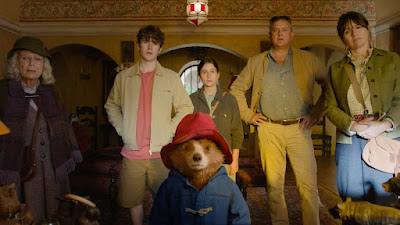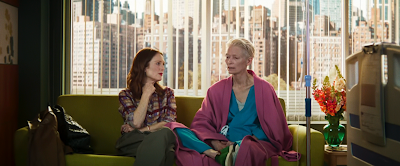Like Nicole Kidman and Hugh Grant before him in, respectively, “Paddington” and “Paddington 2,” Antonio Banderas is granted a chance to cut loose, have fun, and live a little onscreen in “Paddington in Peru.” Given the nature of his character, treasure hunter and riverboat captain Hunter Cabot, I could not help but have flashbacks to Antonio Banderas in a similar movie, “Indiana Jones and the Dial of Destiny” (2023). There, however, and through no fault of his own, really, just the script’s, he was dour and unforgettable; truly, I could not summon one memory of his performance at all. That’s why given the storyline of the third film in the beloved “Paddington” series in which the eponymous Peruvian bear (voiced once again by Ben Whishaw) and his adopted family the Browns travel to his native land on a rescue mission, of sorts, for his beloved Aunt Lucy (voiced by Imelda Staunton) only to get mixed up in a search for El Dorado, I could not help but think this third movie in the series as the unintentional yet, nevertheless, delightful corrective to the fifth Indiana Jones movie.
That is not to suggest “Paddington in Peru” reaches the level of its predecessors, especially the dazzling second installment. The director of the first pair, Paul King, has departed and with him a true sense of vibrant visual filmmaking, not to mention editing vigor. The style of King’s replacement, Dougal Wilson, does not plod, exactly, but comes across more efficient than effulgent and means the movie isn’t a drag but a little too dutiful, connecting the dots with agreeable professionalism rather than charming pizazz. Despite that, he never over-emphasizes the broad human lessons that Paddington preaches, finding the sweet spot between spelling them out for the kids and marrying them to the narrative for the adults, delightfully conveys one spider-centric set-up and payoff embedded in the three-person (Mark Burton, Jon Foster, James Lamont) screenplay, and more than anything, emphasizes the actors and never impedes on their having a good time.
True, I might have liked to see Emily Mortimer (replacing Sally Hawkins) get a more of a chance to cut loose as Mrs. Brown, just as I might have liked to see the Brown kids get a bit more involved in the action. But as a (not so) benevolent nun, Olivia Colman mines great comic mileage from her shifty anime-ish eyes (and sings a song that got stuck in my head - really emphasizing those syllables in “Pe-ru”), Banderas has even more fun in a dual role as vainglorious conquistador Lope de Aguirre, like a History Channel re-enactor shading into madness, and then there is Hugh Bonneville returning to the fold as Mr. Brown. The series might undoubtedly be made in the spirit of Paddington’s sunny optimism, but to a smaller degree, it is also made in Mr. Brown’s risk-averse nature giving way to a nascent sense of adventure. And though so many performers in this joyful trilogy have been noteworthy, it is Bonneville that has ultimately left the most lasting impression on me, always hilariously, heroically straining to let that stiff upper lip curl into a devil-may-care grin.











